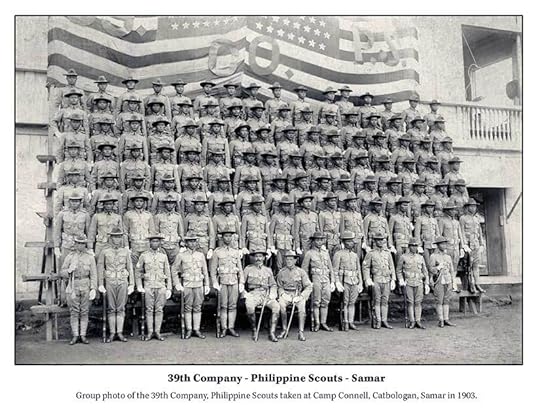Jennifer Hallock's Blog: Sugar Sun Series Extras, page 9
May 20, 2018
Sugar Sun series location #13: Catbalogan
Catbalogan means “an everlasting place of safety,” and for hundreds of years it was safe—for pirates. The sheltered bayside harbor lies just north of the San Juanico Strait between Samar and Leyte, a key access point to the Pacific Ocean and the primary shipping route for the Spanish galleons. Since these vessels were headed to Manila with silver and then back to Acapulco with a hold full of porcelain and spices, they were ripe targets for pirates, right? And by “pirates” I mean the English and the Dutch privateers, who were licensed by their sovereigns to interdict and steal the Spanish bounty. Catbalogan became a haven for pirates and privateers, their crews, and lost sailors.
 The southern mouth of the San Juanico Strait is right near Tacloban. Start there and follow the curve north and west into the bay above Leyte. The strait is 38 kilometers long and, at its narrowest point, 2 kilometers wide.
The southern mouth of the San Juanico Strait is right near Tacloban. Start there and follow the curve north and west into the bay above Leyte. The strait is 38 kilometers long and, at its narrowest point, 2 kilometers wide.The Americans would find the city no easier to manage in the early twentieth century. For the first year of the Philippine-American War, the Yanks mostly ignored Samar because they had their hands full in Luzon. But then, in January 1900, gunships arrived offshore Catbalogan and sent a messenger to General Vicente Lukban, the Philippine revolutionary in charge of Samar and Leyte. The Americans wanted to negotiate a surrender of the whole island by offering Lukban the governorship of Samar. But Lukban wanted more than a title; he wanted full local autonomy. The Americans refused, so Lukban forbade them from landing. In turn, the Americans began to bombard the town. In other words, things escalated fast. Unable to withstand the US Navy’s firepower, Lukban and many of the locals abandoned Catbalogan, burning it as they retreated.
What followed was a ruthless two-year war to subdue the revolutionary forces in Samar. Company C of the Ninth Infantry was stationed to Balangiga to prevent Lukban’s men from using the southern port to import arms and supplies. On its own accord, the town ambushed the garrison in September 1901, and the American military took revenge on all of Samar. General Jacob Smith (known in the press as “Hell-Roaring Jake”) vowed to make the island a “howling wilderness.” Dusting off a legal gem from the American Civil War known as General Order 100, the Americans aimed to starve, burn out, torture, and kill as many guerrillas as possible. Catbalogan and Tacloban (Leyte) were the centers of American authority in this period.
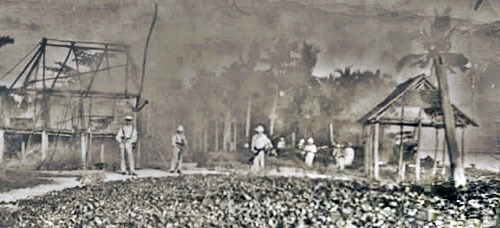 USS Vicksburg sailors led by Lieutenant Henry V. Butler (later rear admiral) burning a village in Samar, October 1901. Photo courtesy of Arnaldo Dumindin and his excellent website on the Philippine-American War.
USS Vicksburg sailors led by Lieutenant Henry V. Butler (later rear admiral) burning a village in Samar, October 1901. Photo courtesy of Arnaldo Dumindin and his excellent website on the Philippine-American War.General Smith’s “short, severe war” was both. But one might argue that it prompted the April 1902 surrender of Lukban’s forces in a grand ceremony in Catbalogan. (Lukban himself had already been captured.)
Those surrendering had to turn over their rifles captured from Balangiga the previous year and pledge loyalty to the United States, but then they were freed. Lukban himself would become mayor of the Tabayas province (now Quezon) within ten years. This begs the question of whether it was the severity of the fight or the quality of the peace that pacified the countryside? Amnesty is not used much in America’s modern war playbook, and I wonder if this is an oversight.
There is an interesting fashion note worth mentioning: the Americans did loan the revolutionaries a few Singer sewing machines so they could surrender in style with new (and complete) uniforms. Pride was salvaged all around.
This is not the end of the story, though. This first war—including the destruction of half the municipalities in Samar and the burning of tens of thousands of tons of rice—caused a lingering famine and sparked another war two years later. Today, we call this phenomenon “blowback.” The Pulahan War was both a civil war (inland highlanders against lowland merchants and farmers) and an anti-American insurrection. On the American side, it was fought by the Philippine Constabulary, Third District—a civil police force organized, funded, equipped (not well), and trained by Americans (usually former soldiers). And by the 39th Philippine Scouts, trained and equipped (with better rifles) by the US Army. Both these units had significant troop presences in Catbalogan, along with the 6th, 12th, and 21st U.S. Infantries.
 The 39th Company, Philippine Scouts, stands at present arms outside their barracks in Catbalogan, Samar. Photo courtesy of Scott Slaten of the Philippine-American War Facebook group.
The 39th Company, Philippine Scouts, stands at present arms outside their barracks in Catbalogan, Samar. Photo courtesy of Scott Slaten of the Philippine-American War Facebook group.Catbalogan was a highly fortified town, but it was still beautiful. The ring of mountains separating it from the suffering of the rest of Samar did make for a stunning backdrop.
 Colorized vintage postcard of a steamer coming into to dock at Catbalogan, Samar, Philippines. Scan courtesy of Scott Slaten of the Philippine-American War Facebook group.
Colorized vintage postcard of a steamer coming into to dock at Catbalogan, Samar, Philippines. Scan courtesy of Scott Slaten of the Philippine-American War Facebook group.The city fared better than the rest of Samar through the lean times, too. Though the galleons no longer journeyed back and forth to Spain, Catbalogan was a center of the abaca trade in the 19th and 20th centuries, hence the large buildings and church. Abaca, also called Manila hemp, was in high demand as naval cordage. Its trade was dominated by ethnic Chinese and British merchants, and once Samar was no longer in ashes, the fiber would revive and bring an influx of capital to Catbalogan.
 Filipinos making rope. This photograph shows the hemp as it comes from the leaves and is put on the spool for winding. Courtesy of the Philippine Photographs Digital Archive.
Filipinos making rope. This photograph shows the hemp as it comes from the leaves and is put on the spool for winding. Courtesy of the Philippine Photographs Digital Archive.The busy port was a bit out of town and had to be reached via a causeway along the coast.
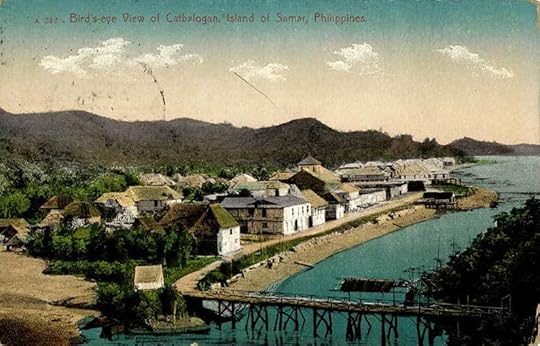 Vintage postcard of Samar with a view of the wooden causeway connecting town to the port. Scanned image of the early 20th century card by Leo D. Cloma.
Vintage postcard of Samar with a view of the wooden causeway connecting town to the port. Scanned image of the early 20th century card by Leo D. Cloma.In the early twentieth century, Americans complained about the lack of poultry, eggs, and fruit in Catbalogan. (I find the fruit claim hard to believe.) They also complained about the lack of dedicated school buildings—not one in the whole town—and the lack of teachers. (Whose fault is that?) And they complained that there were only five miles of road on the whole island. (But how far were civilians likely to travel, anyway?) I traveled to Samar in 2005—and though I would not recommend December for your trip because of the rain, I loved it. The island is just as breathtaking as the postcards from 100 years ago.
 Another view of the coast and causeway from the Quarterly Bulletin of the Bureau of Public Works.
Another view of the coast and causeway from the Quarterly Bulletin of the Bureau of Public Works.
May 11, 2018
Happy Mother’s Day to the Sugar Sun Moms
It is interesting that all my heroines end up with babies in their arms (or their bellies) by the end of my books because I never chose to have children myself. My life may be an unfair comparison since I have had modern science to help me avoid parenthood. Women in the Gilded Age had limited access to contraception, even if they were married and had a sterling reputation. My heroes would have had some access to condoms—called male safes or preventatives in nineteenth-century America—but even these would be harder to order in the Philippines.
But I may be missing the point here. All my heroines want babies. I feel their biological clocks ticking—tick, tick, TICK—even though my own is silent. Nor do I think babies are required for the HEA. Even marriage is not necessary. Nevertheless, the first thing I think about when writing an epilogue is: “What are the kids going to be named?” And I guess, when you get right down to it, this is part of the answer for me: I love names. I just love them. And I love naming future children and thinking about how that name will shape the kid as he or she grows up. I know, it’s weird. But here we are, with three heroines with (more than three) babies. And Happy Mother’s Day to them all, I say! And Happy Mother’s Day to you, even if like me your “child” has four legs and a tail. Or feathers. Or fins. Or whatever.
Let’s start with the latest novella, Tempting Hymn, which has a scene with a pet carrot…

Here’s the epilogue from the opening novella in the series, Hotel Oriente:

And since you’ve made it this far, I have a special treat for you: a snippet of Javier and Georgina’s daughter Pilar and son Jaime from the upcoming Sugar Moon. This is told from the point of view of Allegra Alazas, who visits her cousin-in-law Georgina after the birth of the second Altarejos child.
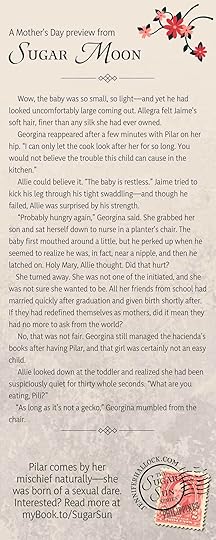
You can find out all about Pilar’s “competitive” conception by reading Under the Sugar Sun. And doesn’t that sound like fun? Happy Mother’s Day, everyone!
May 6, 2018
Inspiring Words from Beverly Jenkins
I don’t usually spring for the master class at conferences, but to hear Ms. Beverly Jenkins?! Yes, please! I was doubly excited when she said that this was the very first master class she had ever given. And triply excited—I know that’s not a thing—when she said her talk would be about world building. Perfect for a historical fiction author!
She talked about a book being like a painting: your hero and heroine are front and center, but the background is full of the details of your world. The beauty of the painting depends on these details, no matter what genre of fiction you write, from science fiction to historical. The geography of our stories should not just be what town or state or country they are in, but all the small details that add life to that image—from weather to topography to points of interest.

Ms. Bev illustrated each point with examples from her own writing, especially two of my favorite books of hers: Indigo and Forbidden. But it was the Blessings series (a contemporary saga) that stole the show. I was completely smitten with the tales of Cletus, the 600-pound hog who wore human clothing, killed a man by sitting on him, and then went on the run from the law. (Yes, a hog went on the lamb. Awesome, right?) The whole audience very quickly felt like we knew the town of Blessings better than the one we were sitting in. Ms. Bev is a master world-builder.
We were treated to a long Q&A session next, and if you have heard Beverly Jenkins speak you know how clever and funny she is. There was a lot of nodding along with her insights on publishing, and also a lot of laughter. You bet I asked her about stuff relevant to my History Ever After talk at IASPR next month. When I asked if any editor or industry representative had ever asked her to change anything historical about her books, she said, “No, not a thing.” That is enormously refreshing, to be honest, given that Ms. Bev writes all kinds of underrepresented American history. She calls it “edutainment,” and there is not a duke in sight. What she did say, though, was that when Forbidden came out in France, they chose a white woman for the cover—and Eddy is not the one who passes, the hero Rhine is. “Oh, Jesus, is right,” Ms. Bev said.
She ended with some inspiring advice for all us writers out there. I could not get it all down, but here are some of the pieces I did quote:
“The 38th book is just as hard to write as book one.” (Note: This is somewhat scary news since the fourth is hard enough for me right now!)
“It’s your book. Write it the way you want to write it.” (Yes!)
About writing the tough stuff from your own experiences: “Tell your story. [The readers] are not looking for you to sugar coat it.”
The woman is not a legend for nothing. Beverly Jenkins was such a wonderful person to talk to and to learn from—a highlight of #NECRWA18 for me. Thanks so much, Ms. Bev!
April 30, 2018
Ben Potter of the Ninth
A week ago, I re-introduced you to Allegra Alazas, the heroine of the upcoming Sugar Moon. She already has a fan club because she stole every scene she could in Under the Sugar Sun.
Her hero (or anti-hero?) is a different kettle of fish. Ben Potter is not someone you were supposed to like in the past book—and yet I always intended to give you his story because it needs to be told.
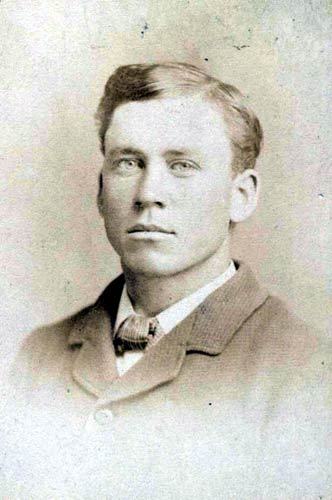 Imagine Ben Potter as a little rougher-around-the-edges version of this photo of Almanzo Wilder.
Imagine Ben Potter as a little rougher-around-the-edges version of this photo of Almanzo Wilder.Ben is loosely based on the real men who served in Company C of the Ninth U.S. Infantry. These men fought at San Juan Hill in Cuba during the Spanish-American War. Just as soon as they returned to their home barracks in upstate New York, they were shipped out again to the Philippines.
What had been meant as a sideshow the war against Spain became the first American imperial war overseas. In March 1899, only one month after tensions between Filipinos and Americans erupted in open combat, the Ninth was sent to reinforce the area around Manila. But they did not stay there long, either. After fighting in several battles that year, they were shipped to China to rescue to the American legation in Beijing (known back then as “Pekin”) during the Boxer War. They scaled the walls of the Forbidden City and camped in the palace grounds.
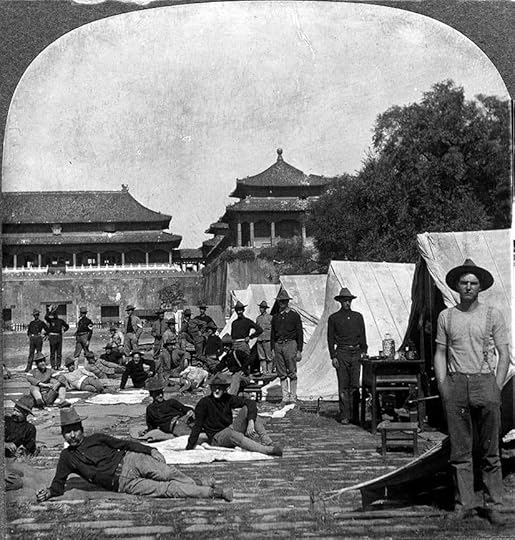 The Ninth U.S. Infantry in the court of the Forbidden City. Image accessed from the Library of Congress.
The Ninth U.S. Infantry in the court of the Forbidden City. Image accessed from the Library of Congress.One might question what the heck America was doing. A war against Spain fought in Cuba had blossomed into a new war in the Philippines that lent soldiers to fight yet another campaign in China. Talk about mission creep. Yikes. Progressives in the Republican Club of Massachusetts claimed in a 1900 leaflet that the end justified the means: “Isn’t Every American proud of the part that American soldiers bore in the relief of Pekin? But that would have been impossible if our flag had not been in the Philippines.”
Once the foreign powers—Europe, Japan, and America—consolidated their hold on mainland China, the Ninth was sent back to the Philippine-American War. Their vacation was the steamer trip to Manila. There, the battle-weary group was given the privilege (and bother) of serving as honor guard for newly-named civilian governor (and future president of the United States), William Howard Taft.
Two years into their overseas rotation, this company of grizzly veterans was sent to one of the roughest outposts in the islands: Balangiga, Samar. Tasked with closing the port to trade—thereby preventing weapon smuggling to the Philippine revolutionaries—Company C settled down to village garrison life.
These men may have been the worst possible choice for this task. By this point, they were unlikely to trust anyone. In addition, some soldiers were likely suffering from what we would now call Post-Traumatic Stress Disorder. Finally, they were cut off from the rest of the world, without even mail call since they were not on the main steamer line. Private Patrick J. Dobbins wrote to his family:
One man in my company went crazy a week ago and escaped to the hills, probably to be killed and eaten by the natives. Another, who was sick unto death, committed suicide this morning at 6 o’clock. His name is Schechterle and he enlisted at the same time I did in Boston. . . . A grave has been dug near our quarters, and a guard of eight men are over the grave. The body is being lowered into the earth. The flag is at half mast. Three volleys are fired, taps is sounded. It is his last call, ‘absent, but accounted for.’ He is better off. Many of us watch him as he is gently lowered with envious eyes.
Though the commanding officer of Company C, Captain Thomas Connell, was a West Point graduate (1894), he did not manage his garrison well. At first too permissive, he became stringent when he realized that his next promotion was on the line. He felt that the villagers were not obeying his commands to “clean up” the streets, so he ordered Company C to round up all the men and keep them prisoner in two tents on the square.
Yes, my character Ben will try to stop all of this from happening, but history is history. He will not be successful. A week later, the town—with help from guerrillas in the jungle—would ambush the company, killing 48 out of 74 Americans. This was real war with real consequences.
 The 1st Reserve Hospital in Manila (1900), similar to the field hospital in Basey, Samar, where Company C survivors would have been tended. Photo courtesy of the Philippine-American War Facebook group.
The 1st Reserve Hospital in Manila (1900), similar to the field hospital in Basey, Samar, where Company C survivors would have been tended. Photo courtesy of the Philippine-American War Facebook group.Obviously, my imaginary Ben Potter lived—or did he? For families like his in America, it would have been hard to know. Names in the real reports were spelled wrong. Numbers changed. It felt like even the Army did not know who had survived. When I found a real article in the Manila Times about a sister writing to a missing brother, I rewrote it in my mind to fit fiction:
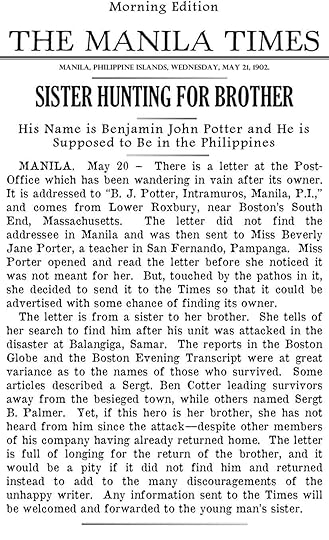
This is a lot of backstory, to be sure. And it is only backstory, not the plot of my book. But I think it is critical history that Americans have forgotten and been doomed to repeat: the Philippines was the Vietnam or Iraq (or Syria?) of the Gilded Age.
Ben lives through these events as a very young man, and they will haunt him for years. Love may not be a cure for combat trauma, but it can encourage Ben to face his past—especially when that past threatens his future with this amazing woman.
April 23, 2018
NECRWA This Weekend!
It was a long Monday, and I’m feeling like this weekend cannot come soon enough. NECRWA 2018, baby! Have you registered yet? This is the only way to see my workshop with RedHeadedGirl of Smart Bitches, Trashy Books on practical history research:
There are so many other amazing workshops, including Namrata Patel’s two-workshop series on SEO, or search engine optimization. Honestly, that’s worth the registration fee right there. And whether you are a reader or writer, you do not need to register to come to the amazing book signing this Friday night from 6-8:30 pm. Admission is free and there are over 35 raffle baskets you could win! And look at those authors!
For example, you could win the basket that Jen Doyle and I made:
[image error]
There is going to be more in here, but I just don’t know what yet. The theme of location-driven romance is a throwback to our amazing #RT17 road trip, but without the Peachoid—because honestly that you have to see to believe.
Come on out to NECRWA 2018!
April 20, 2018
Introducing Allegra Alazas
Do you ever make imaginary friends with a character from a book? I do all the time. These are often characters I have made up in my own mind—and yet I still need to get to get acquainted with them from scratch like they’re strangers. If I have done my job right, by the time the book is ready to print, the hero and heroine are my family. I love them.
Sometimes a character does not wait for her own book. She steals the show from the first moment she is introduced. Such a character is Allegra Alazas, the fiercely loyal cousin of Javier Altarejos, and the woman who plays his matchmaker in Under the Sugar Sun.
Sugar Sun‘s heroine Georgina Potter first meets Allegra in a store on the Escolta, in Manila. As she tells it:
Señorita Allegra was perfectly happy to keep the conversation going all on her own, just as she had done for the past half hour. They had met by chance at a dry goods store, and Georgie had not been able to shake the woman since. Allegra could not believe that any American would walk the Escolta without shopping, so Georgie now found herself unfolding a delicate slip of lace, pretending to consider it despite its prohibitive price. Even though Georgie was supposed to be getting married soon, she did not feel sentimental enough about the occasion to plunge into debt over it. This treasure was not for her.
Allegra kept talking. “I have to sew my flowers on dresses now, though Hermana Teresa will jump off the Puente de España before she believes it. Yesterday she says I will fail domestic labors class. Fail! So I say it is okay—one day I will hire her as my costurera. Do you hear nuns curse before? Very quiet, but they do.”
No doubt nuns cursed around this young woman a lot, Georgie thought. Allegra looked demure but was really quite untamed. Black, roguish eyes set off her fair, delicate skin. Her pink lips were small but curvy, as exaggerated as the outlandish words that came from them.
She sounds like fun, doesn’t she? Allegra—or Allie, as she will soon be known—was inspired by the lantern slide photo above. True story. It was the look on this woman’s face that won me over. I thought her story had to be written.
 Want more Sugar Moon teasers? I could not keep myself from posting these.
Want more Sugar Moon teasers? I could not keep myself from posting these.If I had to cast a movie version of Sugar Moon (and I am open to offers), I would love to see Maine Mendoza in the role:
You see the resemblance, don’t you? It is all about the attitude.
Well, I’d better get back to it, or else you will never get to read Allie’s story. I had to do a massive rewrite this past winter, and I’m about 40% through the Big Edit now. There are some complicating factors that make this book tough. The history is real, and I do not want to skim over that fact. (As author Elizabeth Kingston pointed out recently, colonialism needs to be critically examined, even in romance. Actually, especially in romance. I have tried to do this, and I will keep trying—which to me means not ignoring the difficult stuff.) Also, Ben has to be carefully transformed into hero material; he was not likable in the previous book. But he will be, I promise. Barring major problems, I am gunning for a September release. Fingers crossed.

April 13, 2018
Baseball teaser from Sugar Moon
In the Sugar Sun series, I have attempted to combine the authenticism of well-researched historical fiction with the emotional payoff (the feels) of romance. The more tragic the history in the book, the more important it is to lighten the mood when I can. Music cannot be made with only one note, nor even one movement. A really good read should be like hearing a whole symphony.
Ben Potter’s past is pretty dark: war, opium addiction, combat trauma, and more. So he seeks out the light: the capable but audacious school teacher, Allegra Alazas. And he will have to win her heart in the light—the sunlight, to be exact. It will be out on the baseball field where Ben wins Allie’s hand.
(Yes, I am not only taking on historical romance and historical fiction, but I am throwing in some historical sports romance, too. What bang for your reading buck!)
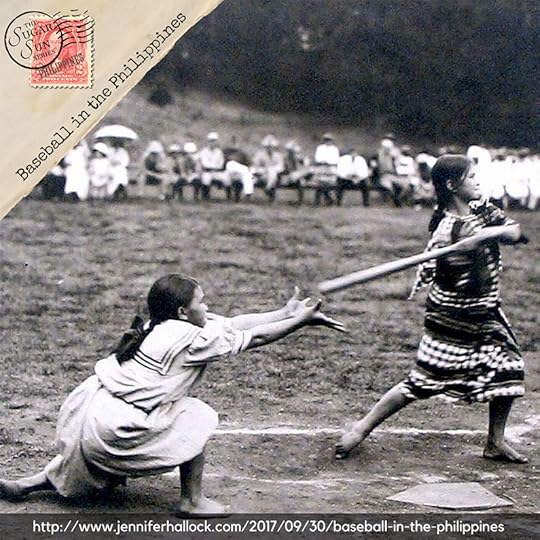 Baseball was a perfect metaphor for American colonial rule. Find out more.
Baseball was a perfect metaphor for American colonial rule. Find out more.The Americans brought baseball to the Philippines as a part of their educational system. The sport caught on. It even found its way into courtship rituals—feats of valor on the baseball field could replace them on the battlefield. Whereas medieval knights used to win jousts to earn the heart of a lady, now you just needed a good hit. According to sportswriter Ernie Harwell, “Americans, acting as muscle-bound cupids, often played simple grounders and easy outs into home runs so their Filipino friends could escape bachelorhood” (quoted in Elias 45).
Plot bunny! Keep in mind that Allie is an exceptional young woman, and she will not sell herself short. She will not require one run, but eight. And Ben won’t accept any help from the defense; he is going to do this the hard way. Hold onto your hats, folks!

April 6, 2018
Living with a Puppy Emoji

You haven’t been waiting for a puppy update? Gee, that’s too bad. You’re gonna get one.
Wile E. is doing great. She’s about 50% bigger than when we first got her, but she’s still a great size. Mr. Hallock is training her on the recall and how to sit for treats: the important things. She came to us nearly housebroken, though. We had trouble at the beginning with her destroying our power cords of all things, but with the right size chew toys, this problem has cleared up.
However, she may be a bit spoiled. This is our third spoiled dog in a row. I wonder why we always get the spoiled ones? *ahem*
This triptych of a bone steal gives you an idea of what I’m talking about. We were puppy-sitting our friends’ pooch, Shea, who is just a love bug. Notice how unhappy Wile E. (right) is with her small rawhide to start. But guess who ends up with the big bone at the end?

Shea: “What happened?”
Wile E.: (muffled) “Wuf sa maffer?”
What can I say? She’s an only dog-slash-child. But, never fear, because after playing, playing, and playing, the two curled up together to nap on the dog bed. It was so cute. I hope the pictures give you all the dopamines they do me. Happy (belated) National Puppy Day!

March 30, 2018
History Ever After: The Historical Romance Market
One of the components of History Ever After at IASPR in Sydney, Australia, will be a market study of online retailers and their potential influence on chronotopes. (Chronotopes are literary representations of time and space, a term coined by Mikhail Bakhtin). The heavy-lifting of my analysis is still to come, but my data has given me a better snapshot of the industry right now.
Let’s look at the only two major retailers that have subcategories of historical romance are Amazon and Barnes & Noble:

Given big Amazon is, I was surprised they did not have more variety in their categories. English history is relatively pinpointed: with Tudor, Regency, Scottish, and Victorian choices. But some of the other categories—Ancient World, Christian, and Medieval—are huge blocks of time. Moreover, calling something medieval (from the “middle age” between ancient and modern) is a Eurocentric view of history with potential negative connotations that do not fit other areas of the world. For example, the European “Dark Ages” were actually the height of the Islamic empires. China was pretty rocking, too. And, even in Europe, what does one do with a romance set in the Renaissance? And—side note—why aren’t there more Renaissance/Venetian romances?
The Barnes & Noble categories do add more variety, particularly some needed U.S. representation, including: Southern U.S., Native Americans, and Western and Frontier. Also, props for the Prehistoric category: Clan of the Cave Bear, baby! There are two Vikings options. One also includes pirates and sailors, taking it out of northern Europe and thus making it more inclusive. Plus there are some genre-crossing categories: Paranormal Historical, Suspense & Intrigue, and Time Travel. Still, there is not a whole lot of non-Western representation, if you really look at it.
Should these retailers re-examine their categories? I have been observing bestseller lists for over three months now to learn what is selling in the largest quantities. Truthfully, historical romance does not hit the trade lists very often. Contemporary (both adult and young/new adult) and romantic suspense are the biggest sellers. In the first quarter of 2018, only one book—Lisa Kleypas’s Hello Stranger—made the New York Times list.

For those historicals that do make the retailers’ charts, they do so more often on Barnes & Noble than Amazon. This does not mean that B&N sells more overall, but a higher proportion of what they sell are historicals. By the way, those historicals are about a half as likely to include the words duke or duchess in the title if charting on B&N’s top 20 Regencies than in Amazon’s top 20 Regencies.
[image error]
Most bestsellers—no matter which list they are on—are Anglocentric. In the first quarter of 2018, 46% were Regencies, 23% were Scottish (any time period), 18% were Victorian, 5% were Georgian, and 2% were English medievals.

Note that some books listed across two categories, such as Victorian and Scottish, and they were counted in both. Also note that the “Twentieth Century” category is inflated by the appearance of a book entitled White Rose, Black Forest. This romance of a German dissenter and Allied spy during WWII was published by Amazon’s own imprint (Lake Union). Amazon gave it away as a Kindle First read, which means any Amazon Prime member could have downloaded it in the month of February (but it technically wasn’t free). Great for that author, but not so realistic a picture of twentieth-century romance’s market share.
I have also noticed that Amazon stats are heavily impacted by paid newsletter services, like BookBub. I am starting to compile some statistics on just how much. (Stay tuned.)
What about award winners? Looking at 2018 RITA nominees, Regency and Scottish romance are even more heavily represented. Only two historicals on the entire list were not one or both of these categories:

All nominees receive that recognition because they have written a great book, which took a lot of hard work. I will be looking at the last few years of historical winners to see if 2018 was an aberration, but certainly we can say that—paired with the market data—it is a reflection of reader preferences (and, in this case, author preferences, since authors were the judges).
In the end, what do readers want? They want it all. Here’s a wishlist of sorts from the survey I conducted in February 2018:

The best sellers may be the most traditional time periods, but there are readers out there for everybody. Or, at least, that is how I choose to see it.
March 24, 2018
Negligées in the Morning: Army Life in 1901
I just revised my Sugar Moon flashback scenes from Balangiga, a horrible incident that Ben Potter barely survived. While I was doing that, I went down a teensy-weensy research rabbit hole. Again.
I wanted to know what a typical morning looked like in the Army in 1901. That’s sort of tough because the Spanish-American War and Philippine-American War were not written about nearly as much as, for example, the Civil War or the Great War. But Google Books and the Rural New Yorker to the rescue! I found out from the (incompletely excerpted) article below that there was an awful lot of bugling:

If you have gone to summer camp, you know what reveille sounds like:
http://www.jenniferhallock.com/wp-content/uploads/2018/03/Reveille.mp3

What about the others? The twenty-first century U.S. Army came to the rescue here. The day of a soldier has not changed much in 120 years, it seems.
Here is the tune to assemble for roll call:
http://www.jenniferhallock.com/wp-content/uploads/2018/03/Assembly.mp3

After attendance is taken, soldiers were led through basic calisthenics. What did that look like in 1901? Thanks to the Manual of Physical Drill by the U.S. Army (1900), I know it went something like this:
I find it fascinating that the manual states to: “Never work the men to the point of exhaustion.” I think my active duty and veteran friends would laugh heartily at that one. And I think we all would find something to be desired in the instructions for how to dress for exercise:

Negligée? I have all sorts of images in my head there. All. Sorts.
And I do not think any of us are going to exchange our moisture-wicking nylon for flannel. Egad.
After the exercises were over, the mess call would be blown:
http://www.jenniferhallock.com/wp-content/uploads/2018/03/MessCall.mp3
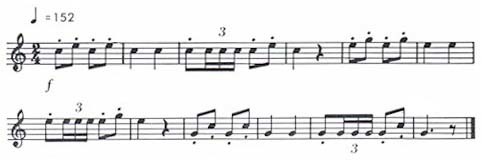
What happened after that? Well, you will have to wait for Sugar Moon to find out! (Or head on over to my Balangiga page for some serious spoilers. Hint: It doesn’t go well.)
Sugar Sun Series Extras
- Jennifer Hallock's profile
- 38 followers




